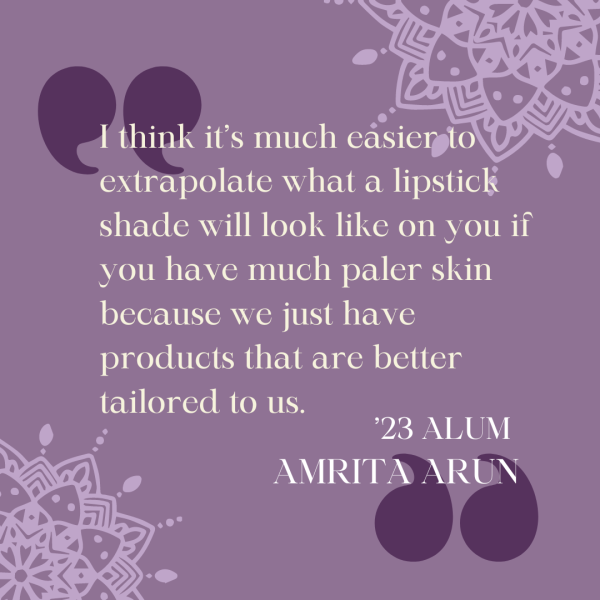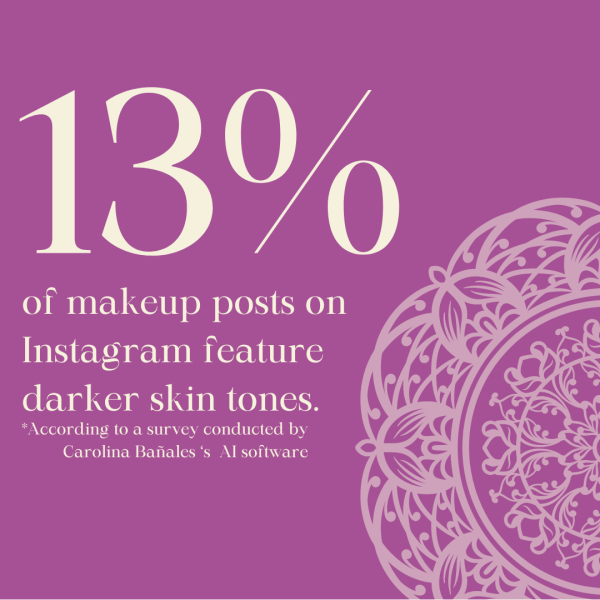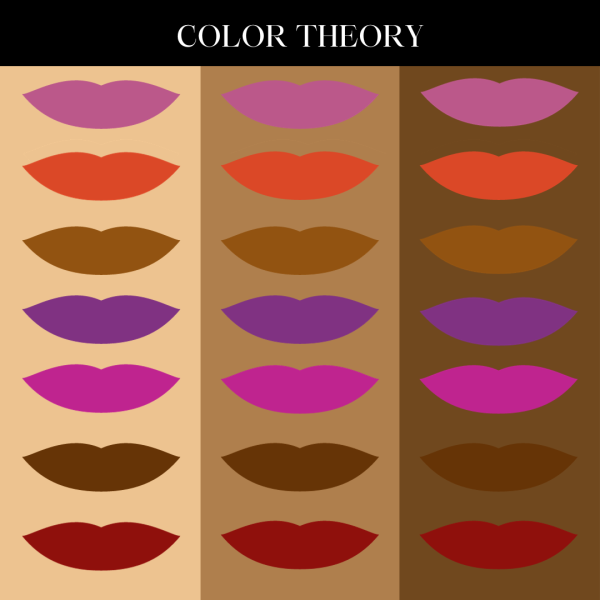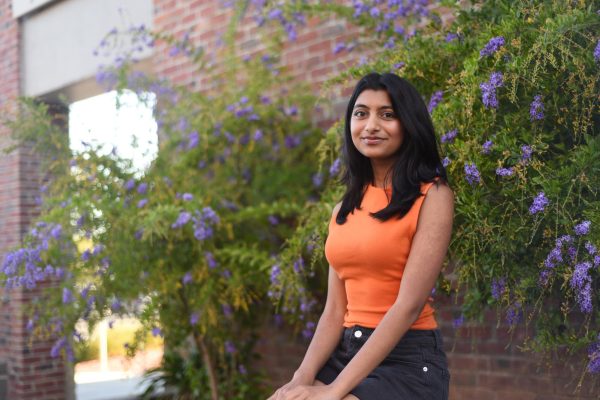As a middle schooler, ’23 alum Amrita Arun would eagerly await with excitement to go to makeup stores like Sephora with her grandma to purchase different lipsticks. With her grandma living in India, Arun rarely saw her and some of Arun’s fondest memories came from these shopping trips together. However, when the pair arrived home to try on the various shades of pink and red lipsticks, the products rarely suited Arun’s grandma while perfectly matching Arun due to her naturally paler complexion.
“She’d be really excited about them and then it just would not look good on her,” Arun said. “I felt really bad about that because she was the one who was more into makeup and I just tried them on. I think it’s much easier to extrapolate what a lipstick shade will look like on you if you have much paler skin because we just have products that are better tailored to us.”

Similarly, seniors Ashika Mittal and Ridhima Katare have had parallel previous experiences in finding suitable makeup products for their respective caramel and brown skin tones when purchasing concealers and foundation, with products often appearing too orange or light. This has caused Katare to explore in-store resources offered by makeup stores like testers. However, Arun feels these testers aren’t helpful enough. With the majority of the shade ranges she finds in store being too fair or light, she believes companies need to address concerns of suitable shade matching by having better representation.
“In-store applicators or samples can be really untrustworthy sometimes based on how they appear because of lighting and with germs you don’t always want to be trying on the samples that might irritate your skin,” Arun said. “The lack of diverse models means a poor representation of women with darker skin, especially with companies advertising lip shades and products. There’s so many lipsticks out there, but unfortunately, there’s just a higher representation of paler people wearing those lip shades and there’s just not an accurate one-to-one translation for the same lip shade but on darker skin.”
To combat these issues, Mittal turns to her older sister for advice on which makeup products suit Mittal and her sister’s skin tones. For example, observing her sister’s use of eyeliner or Kajal — an eye cosmetic applied directly on the upper and lower eyelids — has influenced the subtle eyeliner looks Mittal usually wears. Furthermore, having a similar complexion to her sister has relieved some pressure on Mittal having to look for products alone.
“I try out the product my sister recommends and if it doesn’t work for me, I do the same process [of asking my sister] again,” Mittal said. “It’s much easier to have someone who’s also going through the same process of trying to find the products that look good on their skin tone. I know whatever product that looks good on her will most likely look good on me.”
Meanwhile, Arun and Katare depend on social media, primarily TikTok, to find makeup products that suit them. For example, Arun uses TikTok’s search feature to look up products she finds while in store and browses through popular TikToks to determine if it’s suitable for her pale complexion, and usually doesn’t find issues with the majority of influencers being fairer skinned. Katare has noticed that the majority of the makeup products she uses, such as lip balms or foundation, come from TikTok. Due to the app’s algorithm suggesting viral products, she’s able to refer to brown skinned influencers who test the product to check that these products work for her. However, she feels most of these products sell better due to the company’s targeted advertising.

“The people and companies who are promoting it have a target audience and the viewers who watch it have an unconscious bias,” Katare said. “Things that are more European-centric are more viral because when viewers are scrolling through their page, if they see a white person doing their makeup rather than a black person, they might unconsciously think they like the white person’s makeup more because they trust it more. But really, they have an unconscious bias and that’s why companies do know what will sell better to their audiences.”
Arun and Mittal have found a similar issue of a lack of brown representation when popular makeup trends emerge, with popular makeup influencers having to alter the products or look to ensure the look can be “brown-girl friendly.” Mittal finds that having a community of Indian and social media makeup influencers is helpful, as they inform her about ideal products for her skin type. However, Arun believes the real issue is rooted in popular makeup trends being catered towards paler and white-passing consumers: one example is the strawberry girl makeup trend, a makeup look that features faint pastel pink blushes and lip glosses.
“You’ll find a lot of people engaging in videos of these brown makeup influencers trying on the strawberry girl makeup trend on brown skin,” Arun said. “If the trend truly was inclusive, you wouldn’t have to tag on brown skin when you say ‘trying this trend on brown skin’ because it would already be applicable to everyone. Most of the time, they have to choose different products as well, so it’s clear the trend isn’t user-friendly for everyone.”

Katare agrees, as most of her makeup looks aren’t inspired by popular makeup trends but rather composed of specific products that accentuate her features. For example, Katare favors a bold lip liner with a shiny berry or dark brown gloss to highlight her lips, as most pink colored lip products don’t suit her darker complexion and wash her out. While Katare has found some makeup companies have expanded their product line to become more inclusive, she’s also noticed it seems more like a ploy to attract customers rather than help them.
“If I log in to a makeup site to order a product and go online shopping, I still don’t see brown models,” Katare said. “Sometimes I’ll see one token model and the model will usually be really very light brown and it portrays the idea that lighter people have a cleaner look. The same thing is done with viral products being advertised with the clean girl aesthetic that’s associated with the slicked-back hairstyle. But a lot of ethnic girls just can’t get that look because we have frizzy hair and these companies advertise a new product you can use to make yourself look more like a white girl.”
Arun shares a similar perspective and says that, in general, not only do makeup companies need to have more diverse models who represent different skin tones, but there needs to be a heavier emphasis on color theory: an idea that specific colors will appear differently against contrasting backgrounds, such as lipstick or blush shades on various skin tones. While she says creating universal shades is a step in the right direction, she believes people educating themselves on color theory is a more practical solution.

“The issue now isn’t about the shades themselves because they will look differently on darker skin than they are going to be on lighter skin and that’s just how it is,” Arun said. “But companies can make it easier for darker-skinned women to find the shades that match them by putting it out in the world that they should not be looking for lighter pinks and reds. Instead, they should be looking for browns or maroons or purples and not enough women know that. There needs to be a campaign on these individual makeup brands’ websites that highlights this issue.”










